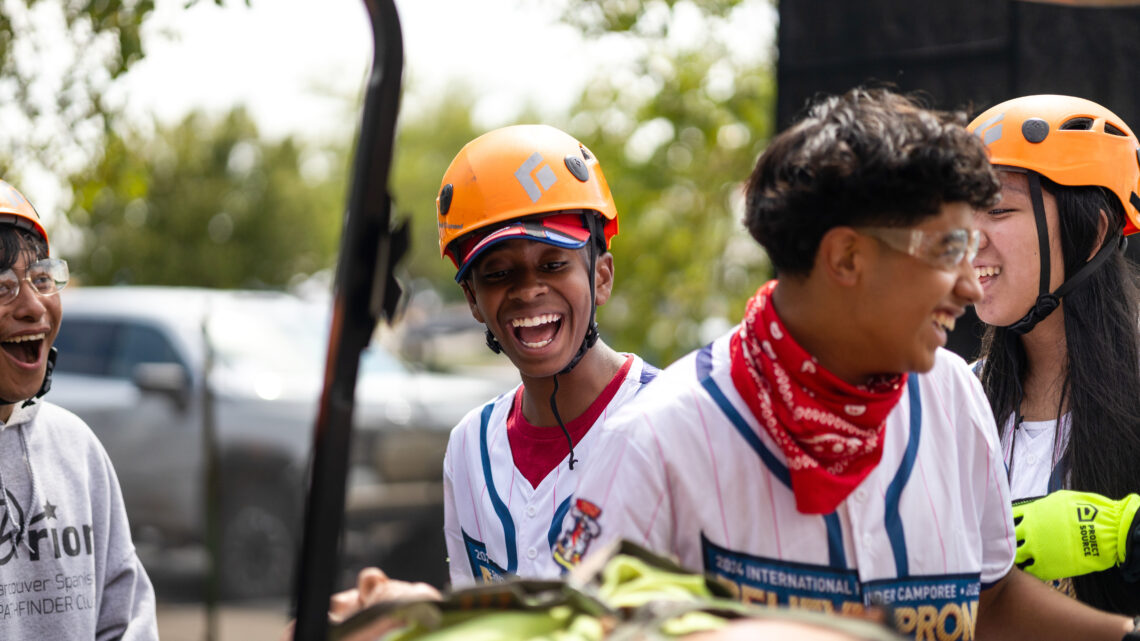Though most of us avoid disasters if given the opportunity, for international rescue and relief majors at Union Adventist University, to “go on God’s errands” often means heading into communities after a tornado, hurricane or earthquake. Pathfinders got a taste of that experience at Union’s Disaster City activity at the 2024 Pathfinder Camporee in Gillette, Wyoming.
“We had people waiting in line for more than two hours,” said Andrew Saunders, the director of Union’s International Rescue and Relief Program. Responsible for Disaster City’s setup, operation, and management, Saunders and the IRR students crafted an engaging and exhilarating experience that was worth the wait.
To begin the timed rescue simulation, teams of eight were given a chainsaw (with the chain removed for safety) and tasked with clearing a tree blocking one of Disaster City’s main roads. Next, they had to avoid fallen power lines using a radio to communicate with a simulated power company. After that, participants repaired a damaged roof by nailing a tarp over it. Finally, the team needed to rescue a two-hundred-pound mannequin, affectionately named Randy, from under a collapsed building. During the process, Pathfinders utilized real tools and techniques taught by the IRR Program.
“Hopefully they were able to see a glimpse of what disaster response can be, and how to use a professional skill set to help somebody else,” explained Saunders. “I think we were able to make a pretty positive impact.”
The activity not only provided education about real-life emergency management, but also gave Union an opportunity to showcase the strength of its curriculum. “It brought a lot of awareness to Pathfinders about the IRR Program,” said Calista Covel, a senior from Topeka, Kansas. “It showed them what Union has to offer and why it might be a good fit.”
The IRR students were pivotal in this success, volunteering time out of their summers to make Disaster City possible. They talked with Pathfinders, guided them through the experience and celebrated their victories.
“I stood and watched the Union IRR team interacting with each Pathfinder in a meaningful and personal way,” said Jodie Aakko, the mother of a Colorado Pathfinder. “What’s more, just when they could have said good-job-have-a-nice-day when a team completed the activity, the IRR team spent several minutes with each Pathfinder, chatting with them, and to extend a personal invitation to join the Union Disaster Response Team when they start college.”
These consistently positive interactions between Pathfinders and students built lasting memories and non-simulated friendships. “We got to meet a lot of really cool people,” said Caleb Bonilla, an IRR graduate now in Union’s Master of Public Health Program. “A lot of alumni came by, and a lot of kids were looking for an exciting, hands-on program.”
Saunders added, “I think our team did very well at representing the values of the university.”
The construction of Disaster City was spearheaded by Savannah Fortney, a 2024 IRR graduate. She built a prop house for the roof-patching scenario and created broken pieces of concrete out of Styrofoam for the collapsed building. She also designed an electromagnetic tree with sections that fell apart when the chainsaw was brought near it. Fortney’s commitment and ingenuity was key to making the exhibit so impactful to the Pathfinders who took part in it.
Disaster City saw a growing number of visitors every day, all enthusiastically awaiting their simulated heroism. “There were always kids in line,” Covel recalled. The activity’s hands-on involvement captivated Pathfinders, and the high-stakes scenarios caused genuine excitement.
Friendly competitions sprung up among the Pathfinders with every team working to earn the best time. A leaderboard was posted in front of the activity, displaying the current record to be broken. This encouraged Pathfinders to improve their time, with multiple groups returning repeatedly. “People would get really into the competitiveness of it,” Saunders said. He added that a group of middle-aged dads had resolved to beat the record their kids set. Clearly, the activity was fun for the whole family.
“I had a bunch of parents come back and say it was the best activity there,” recalled Allen Stafford, an IRR major. “People genuinely loved it.”
Thanks to extraordinary student leadership and an exhilarating premise, Disaster City became a camporee favorite. The effect it had was palpable, attracting a never-ending flow of eager Pathfinders. The disaster may have been simulated, but the fun was authentic. As Aakko said, “I am certain many Pathfinders will remember their thrilling camporee experience at the Union IRR activity when they reach college.”










